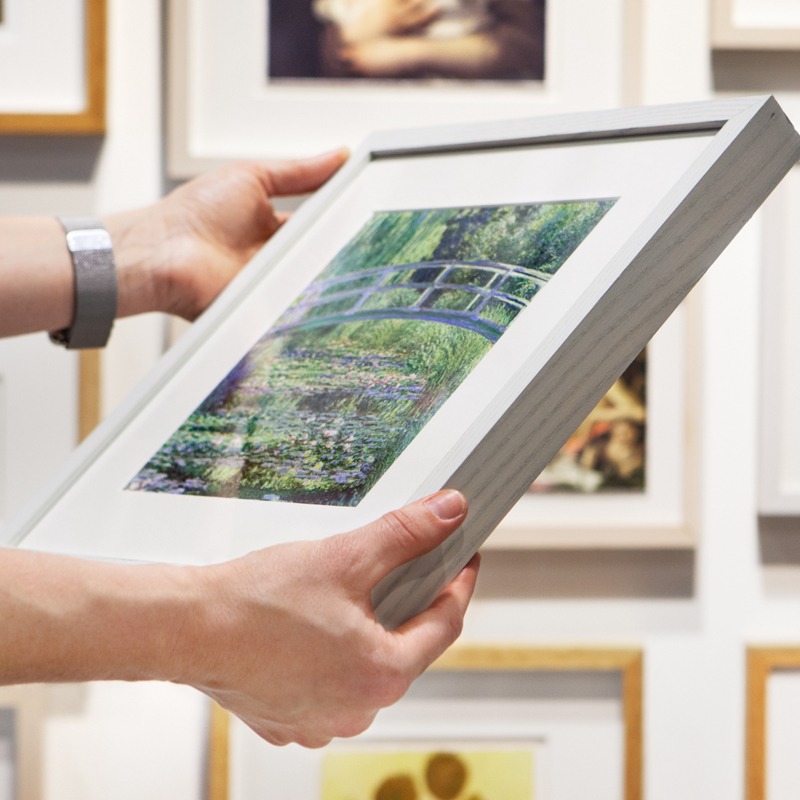Jean-Baptiste-Camille Corot, 'Italian Woman', about 1870
About the work
Overview
A supremely poised young woman is painted in three-quarter view. Her right hand curls around the handle of a mirror, while she appears to be caressing a lock of hair with her left. She wears a white blouse under a black velvet bodice and yellow detachable sleeves over her arms. This study is one of a number that Corot painted during the last years of his life. According to an early biographer, Etienne Moreau-Nélaton, he would take a week out from painting landscapes to paint models in the studio.
Corot had a particular interest in Italian costume, and kept clothes in his studio with which to dress his models. Both the bodice, actually part of a dress, and the sleeves also appear in other paintings. He was not interested in authenticity, but took delight in mixing up the pieces to create a pleasing juxtaposition of colours and textures.
Key facts
Details
- Full title
- Italian Woman, or Woman with Yellow Sleeve (L'Italienne)
- Artist
- Jean-Baptiste-Camille Corot
- Artist dates
- 1796 - 1875
- Date made
- about 1870
- Medium and support
- oil on canvas
- Dimensions
- 73 × 59 cm
- Acquisition credit
- Accepted in lieu of Inheritance Tax by HM Government from the estate of Lucian Freud and allocated to the National Gallery, 2012
- Inventory number
- NG6620
- Location
- Room 41
- Collection
- Main Collection
- Frame
- 19th-century French Frame
Provenance
Additional information
Text extracted from the ‘Provenance’ section of the catalogue entry in Sarah Herring, ‘National Gallery Catalogues: The Nineteenth Century French Paintings’, vol. 1, ‘The Barbizon School’, London 2019; for further information, see the full catalogue entry.
Exhibition history
-
2016Painters' Paintings: From Freud to Van DyckThe National Gallery (London)23 June 2016 - 4 September 2016
-
2018Corot: The Painter and His ModelsMusée Marmottan Monet8 February 2018 - 22 July 2018
-
2018Corot: WomenNational Gallery of Art (Washington DC)9 September 2018 - 31 December 2018
Bibliography
-
1926Kunsthaus Dresden, Internationale Kunstaustellung (exh. cat., Kunsthaus, Dresden), Dresden 1926
-
1936
Wildenstein, G., La Collection Oscar Schmitz: Chefs-d'œuvre de la peinture française du XIXᵉ siècle (exh. cat., Wildenstein & Co., Paris), Paris 1936
-
1937Anonymous, 'Art Throughout America', Art News, XXXV, New York 1937
-
1939Golden Gate International Exposition, Masterworks of Five Centuries (exh. cat. Golden Gate International Exposition, San Francisco), San Francisco 1939
-
1939M. Seton, 'Edward G. Robinson's Collection', The Studio, London, December 1939
-
1940R.J. McKinney, The Development of Impressionism, (exh. cat. Los Angeles Museum), Los Angeles 1940
-
1940L. Ballard, 'Los Angeles Shows the Development of Impressionism', Art News, New York 10 February 1940
-
1943Anonymous, 'Corot in Retrospect: A Note on a Loan Exhibition', The Connoisseur, CXI, London 1943
-
1955Musée de l'Orangerie, Toulouse-Lautrec: Chefs d'oeuvre des collections americaines (exh. cat., Musée de l'Orangerie, Paris), Paris 1955
-
1957The Knoedler Gallery, The Niarchos Collection of Paintings (exh. cat., Knoedler Gallery, New York; The National Gallery of Canada, Ottawa; The Museum of Fine Arts, Boston), New York 1957
-
1958The Arts Council of Great Britain, The Niarchos Collection (exh. cat., Tate Gallery, London), London 1958
-
2014National Gallery, The National Gallery: Review of the Year, April 2012 - March 2013, London 2014
-
2019Herring, Sarah, National Gallery Catalogues: The Nineteenth Century French Paintings, 1, The Barbizon School, London 2019
Frame
Carved from oak, this nineteenth-century French frame in the Louis XV style with a sweeping outline exhibits all the characteristics of a Montparnasse frame – a reproduction style designed to harmonise with the painting’s hues.
The central cartouches on the horizontal sides are smaller in scale than those on the vertical sides and corners. Each pierced cartouche is embellished with a stylised shell motif on a punch-tooled background, flanked by deeply set ‘queue de cochon’ (curled leaf) and ‘rinceaux’ (branches with foliage). Both the back edge and sight edge are decorated with French acanthus leaves. The patina over the gilding has been applied to match the tones of the artwork.
About this record
If you know more about this painting or have spotted an error, please contact us. Please note that exhibition histories are listed from 2009 onwards. Bibliographies may not be complete; more comprehensive information is available in the National Gallery Library.




























